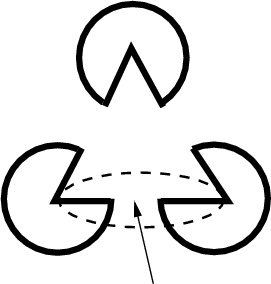
Click on the image to see a PDF version (for zooming in)
Fig. 13.4. Contour completion across edge inducers. After the
retinal and thalamic preprocessing, the inputs received by the primary
visual cortex are essentially edge-detected versions of the original
images, as shown here for the Kanizsa triangle of Figure 13.3a. Each
of the three sides (e.g. the one outlined with a dashed oval) has a
gap (indicated by an arrow). The triangle boundary can be generated by
filling in the gap through contour completion. Contour completion is
therefore a possible mechanism underlying edge-induced illusory
contours.
|